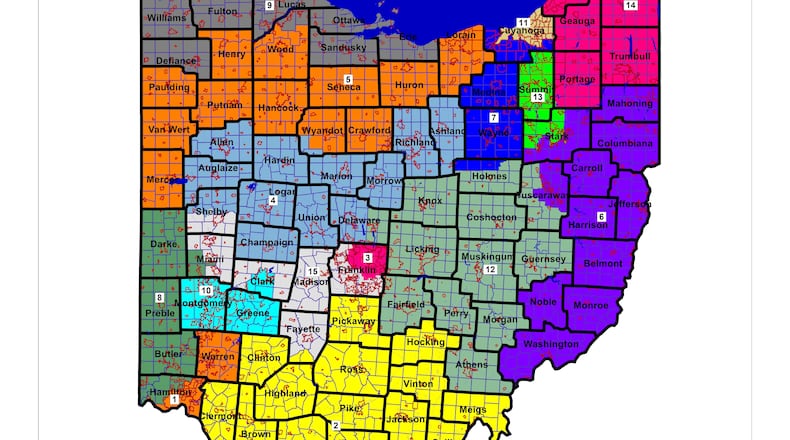One notable change was in District 1, which covers all of Warren and part of Hamilton County. The latest map divides Hamilton County diagonally, with the southeast portion in District 1 and the rest as part of District 8, which also includes Butler, Darke, Preble and part of Miami County.
District 10 remained unchanged from the previous version: It still covers Montgomery, Greene, and south-central Clark County.
District 15 includes the remainder of Clark County, eastern Miami County and parts or all of Shelby, Madison, Franklin and Fayette counties.
Democrats on the commission first moved to take up the map they offered Feb. 8, and then to offer several amendments to the Republican plan. Both efforts were defeated on party-line votes.
Three of the Democratic-leaning seats only do so by narrow margins. District 1 leans Democratic by a hair over 2%. Two other districts lean Democratic by less than 5%, but none of the Republican-leaning districts do so by less than 6.64%, according to the breakdown mapmakers distributed.
The closest Republican district is District 10.
The debate Wednesday featured a long clash between commission members Senate President Matt Huffman, R-Lima, and House Minority Leader Allison Russo, D-Upper Arlington.
Huffman argued that at this stage of the redistricting process, commissioners are not required to pass a map that doesn’t “unduly” favor a particular party. The Ohio Supreme Court has thrown out a previously approved map on grounds that it was gerrymandered to favor Republicans.
“What the courts want, and what I think we all want, is to be able to have an election,” Huffman said.
Russo called Huffman’s assertion “absurd,” especially in light of the court’s ruling, and said passing the Republican proposal would guarantee reconvening in a couple of weeks — anticipating the Ohio Supreme Court would throw out this map too, on the same grounds.
She said Democrats were willing to keep talking about specific changes in order to reach bipartisan agreement. A map passed with single-party support, even if upheld by the court, must be redrawn in four years. A map supported by both parties would be valid for a decade, according to Ohio law.
Russo urged postponing the vote for a day to negotiate, but her proposal failed and the commission’s five Republican members voted to approve the map. The commission had until March 16 to approve a new congressional district map.
Following the meeting Jen Miller, executive director of the League of Women Voters of Ohio, said it’s not a forgone conclusion that the latest map will face another legal challenge, but that will be considered.
“It clearly is a gerrymandered map,” she said. The League of Women Voters is a lead plaintiff in cases that so far have led the Supreme Court to overturn both the previous Republican-backed U.S. House map and two Republican-backed state House and Senate district maps as unfairly favoring Republicans.
In accordance with 2020 census results, Ohio must reduce its U.S. House seats from 16 to 15. Currently Ohio is represented by 12 Republicans and four Democrats.
A primary for all available offices is scheduled to be held May 3, and Secretary of State Frank LaRose — who also sits on the redistricting commission — has indicated there is little will in the General Assembly for postponing that election.
But the state’s county-level boards of election have asked for a postponement in a letter this week to legislative leaders, citing the ongoing legal challenge to state House and Senate maps. The deadline to file for those seats was Feb. 2, and the deadline for U.S. House seats is March 4.
Following Wednesday’s commission vote, Russo said even if the latest congressional map is upheld by the court, she doesn’t believe there is enough time to prepare for a May 3 primary.
In November legislators passed a new U.S. House map, but voting-rights and progressive groups filed suit. The Ohio Supreme Court threw out that map on Jan. 14 and told the General Assembly to try again. The General Assembly took no action, however, sending the job back to the Ohio Redistricting Commission.
The redistricting commission, established by the 2015 constitutional amendment that sought to reduce partisan gerrymandering, consists of co-chairs House Speaker Bob Cupp, R-Lima; state Sen. Vernon Sykes, D-Akron; and members Huffman, Russo, Gov. Mike DeWine, Auditor Keith Faber and LaRose.
About the Author

